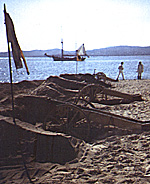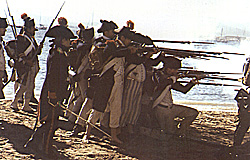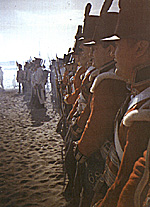"Sun, Sand and Blue, Blue Sea"
Bonaparte 1799 Re-enactment
The Re-enactment Battle
by Steve Vickers and Alfred Umhey
Illustrations by Terri Julians
Photos by First Battalion and Mec Demuth
| |
The Re-enactmentThe scene was first set in the Place Coullet outside the town hall where a tree of liberty (arbre liberté) was erected, accompanied by the singing of La Carmagnole, a regular occurrence, performed by the French troops of the European Napoleonic Society during the bicentennial commemorations. Following this, troops of all armies took part in a torch lit procession in front of the memorial dedicated to Bonaparte's return from Egypt. The first evening's events now complete the re-enactors returned to the Bivouac on the Plage du Veillat to welcome the public who had followed them on the parade.
With all now set La Muiron sailed into view, with General Bonaparte on board. Our recreation of this frigate was actually an ex German army training yacht. The yacht was 50 feet long, had wooden bows and twin masts. La Muiron sailed into the centre of the bay and was met by a flotilla of other vessels including those manned by our own sturdy, freshly trained rowers. As the General was elegantly rowed to shore the French Artillery fired a 12 gun salute into the bay and the church bells rang to arouse the crowd into cheers of "vive la General". After the short journey from La Muiron to the shore the General was greeted by all the troops, the Town Council and other local residents dressed in period costumes to celebrate the occasion. The following procession through the old town finished in front of the Town Hall where the Mayor announced the official opening of the celebrations. The General's ADC stepped forward onto the balcony and announced the arrival of Bonaparte. It was time to turn back the pages of history. The recreation of the disembarkation and return of Bonaparte to France ended here and the following events opened the ENS's own way of commemorating history with military manoeuvres and battles to relive this more gruesome side of Napoleonic history. The Battle on Plage du Veillat Beach
Time was now ripe for the allies to send their main strike force forward and with great precision the First Battalion and the Line and Grenadier Battalions of the Austrian army advanced. The French Artillery found this a daunting enemy and were pushed back onto their own Demi-brigade line. At this critical moment the French cavalry were ordered into the fray; with a rush of hooves, amidst clouds of sand and sea spray, they threw themselves at the massed allied ranks. Although driving the cavalry back, the clash of bayonet and sabre had forced the allies back onto the defensive, reforming once more behind the safety of their artillery entrenchments.
The massive crowd was treated to a spectacular parade of all the troops along the sea line to allow all the attending Regiments to be introduced individually. The march was accompanied by four large Napoleonic military bands and the procession marched off to music of the period and with the cheers of the crowd still ringing in their ears. To add a more civil flavour to the days' military event a concert was held during the evening at Notre-Dame de la Victoire church with a Te Deum by J.Haydn sung by the Estérelenco choir in honour of General Bonaparte. The Battle on Plage du Dramont BeachThe following morning saw the troops move to a beach between St. Raphaël & le Llavandou some 10km away from the bivouac. Although definatley not a Napoleonic battle site it had seen action during World War II. The allies successfully landed here on August 15/16th 1944. The beach was part of Operation Dragoon (originally named Operation anvil) and was code-named Torch Beach. Compared to the Normandy landings the allies were only met with light resistance which led to rapid progress North and West. An event marked by an American landing craft and two large sandstone monuments with the dates 1944 & 1995 inscribed on them. This was to be the background for the next battle. The allies were simultaneously hit from two directions a kilometre apart. Allied infantry were attacked by the Demi-brigades from within a wood with only a small lake for defence and were forced back through a large tunnel into the range and sight of French artillery canister. The French artillery had been bombarding the Austrian artillery and an Austrian Line Battalion, forcing them to retreat, leaving the allies with an uncovered left flank. The battle was reaching its climax.
The allied army retreated in good order down what can only be described as a precipice and onto the beach. However, there were no boats to evacuate the troops from the jaws of the French army's attack. A final defensive position along the tree line at the edge of the beach was chosen for the allies stand. Although the allied infantry were given time to prepare for the attack, the French were able to destroy the Austrian artillery who had been unable to escape down the precipice. With the French artillery now dominating the battlefield, the Demi-brigades opened fire once more and after a short fire fight the allied General was forced to ask for terms. The armies returned to Veillat beach to discuss the treaty. The Discussions Turn Sour on Plage du Veillat BeachAlthough it had been hoped to reach an amicable solution, the talks broke down and hostilities reopened. The troops again deployed on the Plage du Veillat with a renewed determination to finish the weekends encounter once and for all. Both armies had suffered casualties and were now seriously depleted, but both were still intent on the ultimate victory. The main difference now was that the French cavalry had the opportunity to dominate the battlefield, having been assigned to other duties while the morning's battle had raged, they were now fully rested and were ready to deal a crushing blow to the allied forces. This time the armies choose to open the battle with a counter-battery fire, but neither side was strong enough to dent the opposition's defences. The infantry deployed and prepared to attack each other with as much force as could be mustered for one final push. Again neither army could gain the upper hand and tip the scales in their favour. Then, exerting his control, the French general deployed the Artillery and Demi-brigades together and softened up the allies with feu de bataillion and feu de batterie. Forced onto the defensive the allies could only make a limited reply before the French horsemen swept forward. Grasping the moment the French infantry followed up with the bayonet and after a brief hand to hand struggle the battle was won. However, recreating history can be a lot more fun than the real thing. At the end of the battle erstwhile enemies helped their opponents up from the sand and in no time at all both sides launched a fresh attack. Only this time it was aimed at the welcoming blue Mediterranean Sea, and although we were unable to drive back the waves we at least were able to celebrate the completion of yet another highly successful year for the European Napoleonic Society in style. How many other re-enactments end like this!? More Sun, Sand and Blue, Blue Sea
Bonaparte 1799 Re-enactment: The Re-enactment Battle Bonaparte 1799 Re-enactment: The Troops Back to Table of Contents -- First Empire #51 Back to First Empire List of Issues Back to MagWeb Master Magazine List © Copyright 2000 by First Empire. This article appears in MagWeb (Magazine Web) on the Internet World Wide Web. Other military history articles and gaming articles are available at http://www.magweb.com |
 The following morning was to be the recreation of the General's disembarkation. However, rowing the General to shore would take some care on the part of the oarsmen. The sight of a 9e Légère crew coxed by the HMS in full kit each learning how to handle an 8 foot oar needs to be seen – stick to the muskets lads! An hour later each boats coxon decided their crew was ready for the important task of rowing and escorting the General ashore.
The following morning was to be the recreation of the General's disembarkation. However, rowing the General to shore would take some care on the part of the oarsmen. The sight of a 9e Légère crew coxed by the HMS in full kit each learning how to handle an 8 foot oar needs to be seen – stick to the muskets lads! An hour later each boats coxon decided their crew was ready for the important task of rowing and escorting the General ashore.
 Although the beach was narrow, with the sea on one side and the sea wall on the other, it was still large enough for the French army to field 4 cannon side by side with room to spare. The allies dug earthworks and placed their artillery in strong defensive positions. Both armies decided to pitch their light troops against each other first. The allies sent their Austrian Jäger forward to fend off the French light infantry. This was done with ease but the French Artillery had deployed behind the light infantry screen and opened a fearful barrage on the exposed Jägers, forcing them to retire.
Although the beach was narrow, with the sea on one side and the sea wall on the other, it was still large enough for the French army to field 4 cannon side by side with room to spare. The allies dug earthworks and placed their artillery in strong defensive positions. Both armies decided to pitch their light troops against each other first. The allies sent their Austrian Jäger forward to fend off the French light infantry. This was done with ease but the French Artillery had deployed behind the light infantry screen and opened a fearful barrage on the exposed Jägers, forcing them to retire.
 The Demi-brigades massed for an attack on this strong defensive position but were beaten back by cannon fire and musket volleys. The only way to crack this nut was to combine the Demi-brigade attack with artillery support. The storm of musket ball and canister made the allies reconsider their desire for battle until a final bayonet charge forced them to sue for terms. The battle was over and the cheers and applause of the crowd rang out.
The Demi-brigades massed for an attack on this strong defensive position but were beaten back by cannon fire and musket volleys. The only way to crack this nut was to combine the Demi-brigade attack with artillery support. The storm of musket ball and canister made the allies reconsider their desire for battle until a final bayonet charge forced them to sue for terms. The battle was over and the cheers and applause of the crowd rang out.
 The Demi-brigades massed their volley fire against the First Battalion and Austrian infantry, who countered by a frantic attempt at matching the French volley for volley. Meanwhile the artillery of both armies fired on each other until the clouds of smoke covered the field with a real fog of war.
The Demi-brigades massed their volley fire against the First Battalion and Austrian infantry, who countered by a frantic attempt at matching the French volley for volley. Meanwhile the artillery of both armies fired on each other until the clouds of smoke covered the field with a real fog of war.